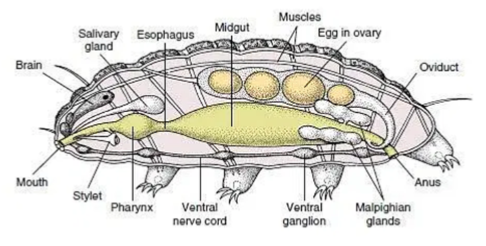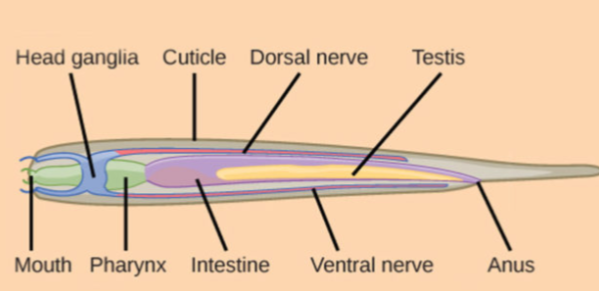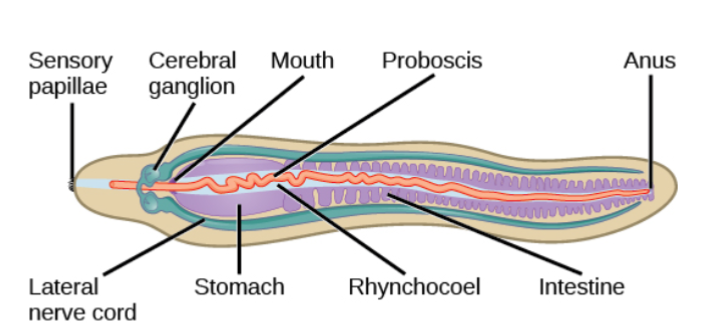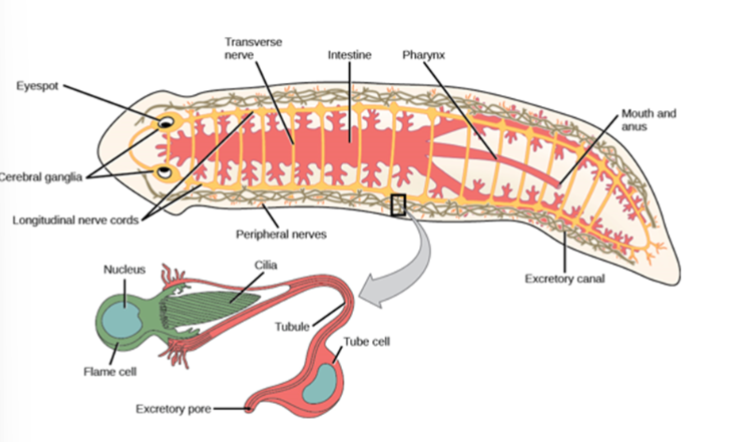Unit 2 Zoo
1/62
There's no tags or description
Looks like no tags are added yet.
Name | Mastery | Learn | Test | Matching | Spaced |
|---|
No study sessions yet.
63 Terms
What is part of the super phylum Lophotrochozoa?
Nemertea, Platyhelminthes
Platyhelminthes Lophotrochozoa have either
• Lophophore feeding apparatus
• Cilia around the mouth
or
• Trochophore larvae
• Larva have two bands of cilia
Which phylums have a BILATERAL body plan
Nemertea, Platyhelminthes, Nematoda, Tardigrada
Which phylums have Triploblastic and Acoelomate tissues
Nemertea, Platyhelminthes
Epidermis for Nemertea and Platyhelminthes
layer of epithelial cells formed from ectoderm tissue
Mesoderm for Platyhelminthes
differentiates into a layer of circular muscle. also differentiates into mesenchymal cells that are excretory
Mesoderm for Nemertea
differentiates into muscle tissue
Endoderm for Nemertea and Platyhelminthes
differentiates into digestive system
Phylum Platyhelminthes AND Nemertea AND Nematoda AND Tardigrada Are
protosome
What is Simple cephalization in Platyhelminthes
Nerve tissue and sensory organs in a head
have eye spots called ocelli (sense intensity of light)
Platyhelminthes free-living species are
predators/scavengers
Platyhelminthes parasitic species
absorb nutrients from host’s gut
Platyhelminthes digestive system is
incomplete (protosomes)
• Mouth is also anus
• Branching gastrovascular cavity (GVC)
• Ingested food goes into branching digestive system
• Food is digested in the GVC then absorbed into cells lining the GVC and transported
throughout the body via diffusion across gap junctions
Platyhelminthes excretory system
network of tubules along the periphery of the animal
-connects to flame cells with cilia that propel metabolic waste out of the body through pores
Platyhelminthes Nervous system
consists of two lateral nerve cords running the length of the body
-cords connect to each other across the body, transverse nerves
-two cerebral ganglia surround ocelli for sensing light and chemicals
have no Respiratory system instead:
-O2 is absorbed through epidermis, Co2 released through epidermis
What does Platyhelminthes, Nematoda and Nemertea not having a respiratory system limit?
thickness of its body
Platyhelminthes have no Circulatory system instead:
Gases and nutrients move via diffusion and gap junctions
Platyhelminthes Reproduction
Most species are monoecious
• Highly regenerative
• Asexual reproduction through fragmentation
• Sexual reproduction, internal fertilization via “penis fencing”
What is penis fencing
• Individuals evert their penises and attempt to stab each other
• When one is victorious, sperm is released into body of the stabbed individual
• Sperm migrate to oviducts and fertilize the eggs
• Fertilized eggs are released
• Larvae hatch and grow through multiple larval stages
Defining characteristic of Nemertea
eversible proboscis
Eversible Proboscis in Nemertea
• Located in structure called rhynchocoel
• Harpoons prey
• Some species’ proboscis has barbs
Phylum Nemertea are usually part of what marine
benthic marine
Nemertea size
varies widely from 1cm to several meters
Nemertea have simple cephalization
• Cerebral ganglia comprise a rudimentary “brain”
• Sensory papillae provide sense of touch
• Ocelli are present in most species
Most Nemertea are
carnivorous
Nemertea circulatory system
• Have closed circulatory system
• Closed loop formed by a pair of connected blood vessels
• Blood flow is maintained by muscle contraction
Nemertea excretory system
a pair of tubules called protonephridia
Removes metabolic waste and maintains osmoregulation (*)
Nemertea nervous system
“brain” of four ganglia around the head and rhynchocoel
• A pair lateral nerves emerge on either side of the brain and travel the length of the body
• Most species have ocelli, often several pairs
Platyhelminthes, Tardigrada, Nemertea and Nematoda have no respiratory system, instead
• O2 absorbed through epidermis, CO2 released through epidermis
Nemertea Reproduction
• Highly regenerative
• Asexual via fragmentation
• Mostly dioecious
Where do Nemertea have gonads
along the digestive tract
What does Nemertea having gonads in their digestive tract mean
• Stem cells differentiate into gametes
• Typically exhibit courtship spawning
• External fertilization
• Larvae develop into trochophore larvae, growth through several larval stages
What superphylum is Nematoda in?
Ecdysozoa
Superphylum Ecdysozoa have
a cuticle (tough, flexible exoskeleton. Molt to grow)
Made of collagen and chitin
What tissues do Nematoda have
triploblastic and psudocoelomate
-Cylindrical tubular morphology
Where do Nematoda’s and Tardigrada’s live
all habitats
Are all Nematodas free-living?
some are free-living and some are parasitic
Phylum Nematoda have simple Cephalization, what does this mean?
• Cerebral ganglia comprise a rudimentary “brain”
• Sensory papillae and bristles provide sense of touch
What kind of digestive system do Nemertea, Nematoda and tardigrada have?
Complete
What makes a complete digestive system
• Has mouth and anus, food travels in one direction
• Well-developed digestive system
• Mouth has lips and teeth
• Prey enters mouth, then pharynx, then intestines
• Solid food waste exits anus
What do Nematoda do without a circulatory system?
diffuse gases and nutrients throughout body
Nematodas excretory system is very simple, how?
metabolic waste is ammonia, removed by diffusion
Nematoda’s nervous system
simple “brain” from which four longitudinal nerve cords
emerge and travel down length of body
• One nerve on dorsal side, two nerves are lateral (one on each side), one ventral nerve
cord is more developed
Reproduction in Nematoda is
Species specific:
• Monoecious
• Dioecious
• Parthenogenic
Reproduction in dioecious Nematoda
fertilization is internal
• Female lays eggs that develop for approximately two weeks
• Larvae molt four times, ecdysis
What superphylum is tardigrada part of?
Ecdysozoa
What is the Tardigrade cuticle made of?
chitin that is divided into plates
What tissues do Tardigrada have?
Triploblastic and eucoelomate
have hemocoel
What unique ability do Tardigrada have?
can suspend metabolism, cryptobiosis
What do Tardigrada’s eat
algae, plants, small animals
What size is tardigrada
very small, less than 1 mm
Tardigrada Morphology
• Cylindrical body with four pairs of legs
• First 3 pairs are for locomotion, last pair is for clinging
• Have bands of muscle for movement of legs
• Have simple cephalization
• Pair of eye spots for sensing light
• Sensory papillae and bristles provide sense of touch
What is different about Tardigradas complete digestive system
mouth with saliva instead of lips and teeth
Tardigrada have no circulatory system, what does it do instead?
Bodily fluid, blood contained within hemocoel
What is Tardigradas excretory system like?
malpighian tubules that transport metabolic waste to digestive system
What is tardigrada’s nervous system like?
simple brain with ventral nerve
individual ganglia extend into each leg
Tardigrada reproduction
dioecious
external fertilization
What does Tardigradas external fertilization look like?
• Reproduction occurs when animals molt
• Eggs are attached to molted cuticle
• Young molt many times at they grow into adults

Tardigrada

Nematoda

Nemertea

Platyhelminthes